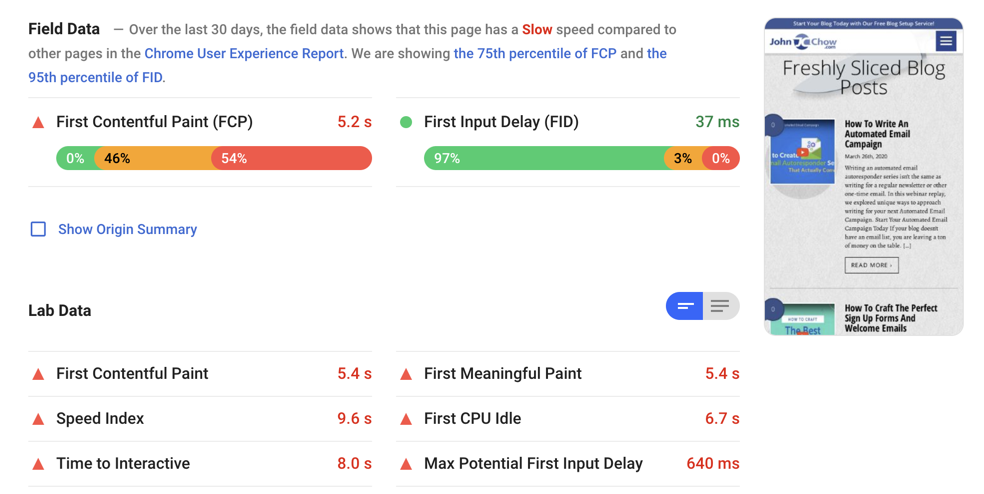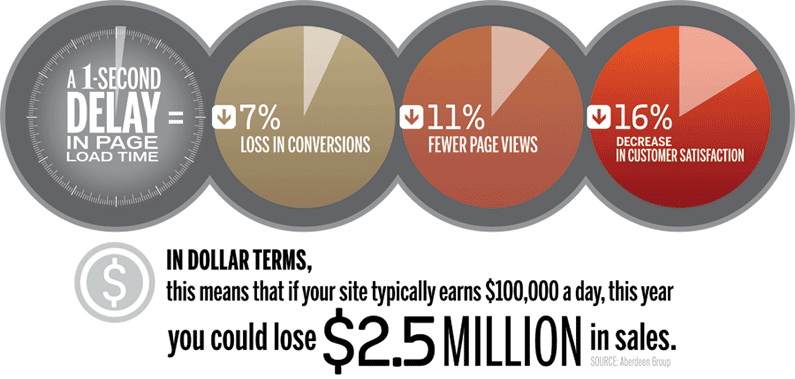When was the last time you visit a website and it took a few seconds to load? You might not remember exactly, but I’m sure you weren’t too happy with the wait. Wow… how impatient we all have gotten over the years! Remember how long everything took back in the age of dial-up?
Well, those days are long gone and speed is everything. With short attention spans and faster internet speeds than ever, there is really no excuse for not having a super fast loading website.
It doesn’t matter if you are a new blogger, a veteran or even a Fortune 500 company… the speed of your site can wipe out all of your projected traffic, search rankings and revenue if it just takes a few seconds too long to load.
In fact, there was even an article published on FastCompany a while back that discussed how a single second in loading time would result in Amazon losing over a billion dollars. Jump forward to today and I’m sure that number is several multiples higher.
The main reason for this is that people get angry when they have to wait, and when people get angry or annoyed… they leave the site they are on. This can be portrayed through the visual below, provided in that same article.

The good news is, when this original article was originally written, it was more of a technical process to improve site speed and the idea of removing excess lines of code from your site or individually crunching file and image sizes would be a complete nightmare.
Jump forward to today, it’s a whole different ball game. And if you are running your site with WordPress, then the process is even easier.
Let’s now take a look at some of the best ways to improve your site speed, while also increasing overall engagement numbers and rankings in the process.
1 – Run a Google Insights Page Speed Test
In order to know where your site needs improvement in reference to loading times, you first need to have some type of report to compare updated numbers with. This can easily be done through the Google PageSpeed Insights tool.
If you were to plug a site URL like johnchow.com into the tool, it would then spit out a nice report like the one below. Not only will it provide you with a Page Speed score, it will also show you where you can make improvements to your site to increase loading times.

With Google being the beginning and end of all things on the internet, they want site owners to use such tools to improve their site speed and performance. Site speed is also one of the highest factors that comes into play when Google’s algorithm is ranking sites.
In short, if you have a slow loading site, your rankings and user experience is likely going to pay for it.
2 – Install WP Smush for Automatic Image Crunching and Optimization
As mentioned earlier, there are many different ways to further optimize your site for improved performance and speed. However, in the past, many of them were through manual coding and design processes. If you are running your site on the WordPress platform, this is a completely different story.
Thanks to the many different WP developers out there, plugins have completely changed the way site owners can customize and optimize the performance of their sites.
Through the use of optimizing images on your site, you can quickly improve the speed and performance of your site. After all, in most cases your images are likely in a much higher file size and format than needed… and optimization plugins like WP Smush can automatically lower file size while also not losing image quality.

The WP Smush Pro plugin has a wide range of features, which include:
- Lossless Compression – Strip unused data without affecting image quality
- Lazy Load – Defer offscreen images with the flip of a switch
- Bulk Smush – Optimize up to 50 images with one click
- Image Resizing – Set a max width and height and large images will scale down as they are being compressed
- Incorrect Size Image Detection – Quickly locate images that are slowing down your site
- Directory Smush – Optimize images even if they are not located in the media library
- Automated Optimization – Asynchronously auto-smush your attachments for super fast compression on upload
- Without Monthly Limits – Optimize all of your images up to 5MB in size free forever (no daily, monthly, or annual caps)
- And more…
Best of all, there is a free plugin that anyone can use and test out right away, and also a premium version that can be upgraded to access more feeatures and tools. Just search for “WP Smush” from within your WordPress dashboard and you can install and activate it right away. Then, if you like what you see, there is also a premium version of the plugin that can be downloaded for further optimization and improvement.
And if you are going to try the plugin out, make sure you run a speed test through the mentioned tool above before loading WP Smush onto your site, and then age after it’s in place. This will allow you to see who much of a speed difference the plugin is accounting for.
3 – Further Optimize and Improve All Areas of Your Site
Now that we’ve covered how you can run a quick speed test on your site and also optimize your image and files sizes with a free WordPress plugin, it’s also important to explore a few other options as well.
When a visitor gets to your site, all they see is what’s on the outside. They never see WordPress, the backend plugins and software or even the web hosting that allows it to be accessed from anywhere in the world.
What they do see, if more reason to leave your site. Again, here is just another reminder of how much a one second delay in page loading time can affect your overall business or brand.

However, it doesn’t have to be this way. All the end user wants is their content, and it’s your job to provide it to them as fast as possible.
Here are a few more ideas and recommendations to consider cleaning up on the backend.
- Unwanted WP Plugins and Themes — As WordPress users, many of us love to try different plugins and themese. However, if there are any inactive plugins or themes sitting on in your dashboard area, they are just taking up space and potentially slowing down your site.
- Reliable Web Hosting — While there are thousands of web hosting solutions to choose from, they are not all created equally. Some of them might actually be run by a kid in their parents basement. Others are run in huge datacenters, or even with Amazon AWS services. In short, always make sure you go with a reliable web hosting company that knows how to efficiently run WP-powered sites and has lots of customer reviews online.
- Remove Lagging Third-Party Integrations — You know all of those cool social sharing plugins, Facebook widgets and other widgets that make your site look fancy and interactive? Well, lots of them are killing the speed of your site as well. And if they are running slow on their end for any reason, they will lag up your site performance even more. Take a look at your site and see if all third-party pixels and integrations are necessary.
When going through your site, it’s important to remember that the cleaner it is, the faster it will load. This is something brands like Apple, eBay and Amazon have been perfecting for years and spending billions of dollars on.
Faster Loading Websites and Blogs = Happier Customers and Higher Profits
It doesn’t matter if you are a hobby blogger, an e-commerce site or selling services online… the speed of your site is going to play a huge factor in how audiences see and respect your brand.
Right out of the box, WordPress is a very fast loading platform, but with further optimization and testing you can make it even faster.
If you haven’t already, head back to the top of this article and click the link to run a speed test on your site. Then, add the recommended WP Smush plugin and also clean up your excess WP plugins and themes… then run the test again and see how it does.
Let us know your results and we can compare who has the better speed score.